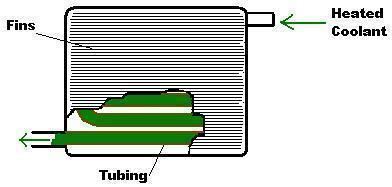 | ||
A heater core is a radiator-like device used in heating the cabin of a vehicle. Hot coolant from the vehicle's engine is passed through a winding tube of the core, a heat exchanger between coolant and cabin air. Fins attached to the core tubes serve to increase surface for heat transfer to air that is forced past them, by a fan, thereby heating the passenger compartment.
Contents
How it works
The internal combustion engine in most cars and trucks is cooled by a water and antifreeze mixture that is circulated through the engine and radiator by a water pump to enable the radiator to give off engine heat to the atmosphere. Some of that water can be diverted through the heater core to give some engine heat to the cabin.
A heater core is a small radiator, located under the dashboard of the vehicle and consists of conductive aluminium or brass tubing with cooling fins to increase surface area. Hot coolant passing through the heater core gives off heat before returning to the engine cooling circuit.
The fan for the vehicle's ventilation system forces air through the heater core to transfer heat from the coolant to the cabin air, which is directed into the vehicle through vents at various points.
Control
Once the engine has warmed up, the coolant is kept at a more or less constant temperature by the thermostat. The temperature of the air entering the vehicle's interior can be controlled by using a valve limiting the amount of coolant that goes through the heater core. Another method is blocking off the heater core with a door, directing part (or all) of the incoming air around the heater core completely, so it does not get heated. Some cars use a combination of these systems.
Simpler systems allow the driver to control the valve or door directly (usually by means of a rotary knob, or a lever). More complicated systems use electronics to control the valve or doors.
Cars with dual climate function (allowing driver and passenger to each set a different temperature) may use a heater core split in two, where different amounts of coolant flow through the heater core on either side to obtain the desired heating.
Air conditioning
In a car equipped with air conditioning, outside air is first forced through the air conditioner's evaporator coil. This can be thought of as a heater core filled with very cold gas, which cools rather than heats the incoming air. In order to obtain the desired temperature incoming air may first be cooled by the air conditioning and then heated again by the heater core. In a vehicle fitted with manual controls for the heater and air conditioner, using both systems together will dehumidify the air in the cabin, as the evaporator coil removes moisture from the air due to condensation. This can result in increased air comfort levels inside the vehicle.
Engine cooling function
Because the heater core cools the heated coolant from the engine it can act as the radiator of the engine. If the radiator is working improperly, the operator may turn the heat on in the passenger cabin, resulting in cooling the engine coolant and then cooling the engine. This idea only works to a certain degree, as the heater core is not large enough nor does it have enough cold air going though it to cool large amounts of coolant significantly.
Possible problems
The heater core is made up of small piping that has numerous bends. Clogging of the piping may occur if the coolant system is not flushed or if the coolant is not changed regularly. If clogging occurs the heater core will not work properly. If coolant flow is restricted, heating capacity will be reduced or even lost altogether if the heater core becomes blocked. Control valves may also clog or get stuck.
Another possible problem is a leak in one of the connections to the heater core. This may first be noticeable by smell (ethylene glycol is widely used as coolant and has a sweet smell); it may also cause (somewhat greasy) fogging of the windshield above the windshield heater vent. Glycol may also leak directly into the car, causing wet upholstery or carpeting.
Electrolysis can cause excessive corrosion leading to the heater core rupturing. Coolant will spray directly into the passenger compartment followed with white colored smoke, a significant driving hazard.
Because the heater core is usually located under the dashboard inside of the vehicle and is enclosed in the ventilation system's ducting, servicing it often requires disassembling a large part of the dashboard, which can be labour-intensive and therefore expensive.
Air cooled engines
Engines that do not have a water cooling system cannot heat the cabin via a heater core; one alternative is to guide air around the (very hot) engine exhaust manifold and then into the vehicle's interior. Temperature control is achieved by mixing with unheated outside air. Air-cooled Volkswagen engines use this method. Depending on the design, this can cause a safety issue where a leak in the exhaust system will begin to fill the passenger cabin with deadly fumes.
Reuse for other purposes
Car heat cores are also used for D.I.Y. projects, such as for cooling homemade liquid cooling systems for computers.
